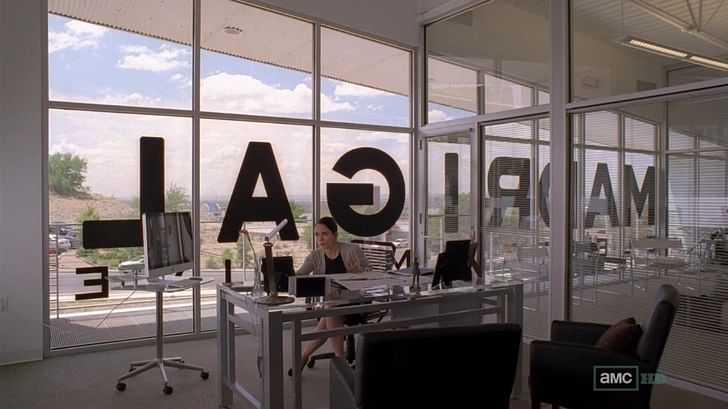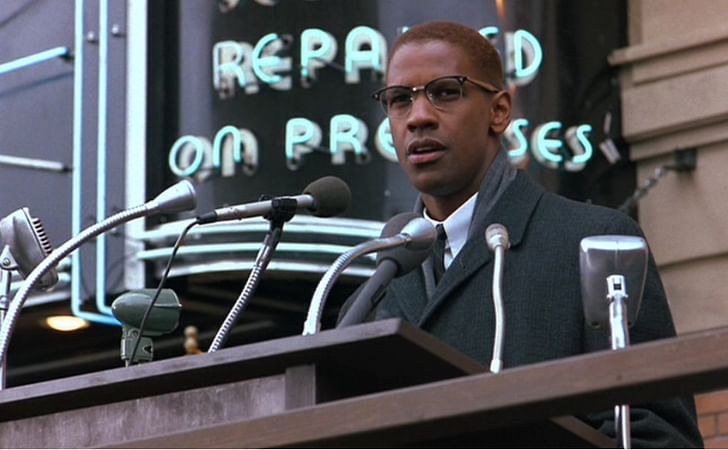

In cinema, signage plays a duplicitous role. Like a cartoon thought bubble, signage is a tangible manifestation of how a character feels, yet it also encourages the audience to read between the etched lines.
Signage is generally understood to mean a commercial or public-use sign, which makes its function seemingly straightforward: it is used to announce and clarify concepts. However, like chapter headings for the damned, cinematic signage obliquely leads us as viewers into the next act of the story. The material on which that signage appears often signals the true emotional state of that film’s characters, whether they realize it or not. A transparent background, such as a glass window, can indicate that the sign’s emotional concept is As a global drug distributor, groundbreaking visionary and affluent former tennis champ respectively, each character undergoes a rude awakening that is heralded by this writing on the wall.transparently obvious to that character, whereas an opaque background indicates that the full implications of the concept may be shrouded or obscured from the character. The material of the lettering can also offer clues into the character's actual emotional state, especially if that sign is made of a bright, ephemeral material like neon.
Consider Breaking Bad’s Lydia Rodarte-Quayle, or Malcolm X in Spike Lee’s eponymous bio-pic, or even Richie Tenenbaum of The Royal Tenenbaums. Each of these characters has some conscious notion of their relationship to the environment, but their cinematic fates are about to take wild divergences. These stories are powerful because at no point is the audience ahead of the narratives; instead, we are invested in each moment as it occurs. We experience shock in real time. And yet, the signage encourages us to anticipate the future, even if we can't predict it exactly. As a global drug distributor, groundbreaking visionary and affluent former tennis champ respectively, each character undergoes a rude awakening that is heralded by this writing on the wall.

As the Head of Logistics at an international manufacturing and shipping conglomerate, Lydia Rodarte-Quayle of Breaking Bad finds herself drawn into a drug empire run by former chemistry teacher turned ruthless cancerous kingpin Walter White. Lydia's role is to procure methylamine for Walter's cabal of cooks in New Mexico, as well as help him distribute his signature blue meth to Europe, from which she makes a tidy profit. With the tremulous voice of a seemingly non-violent professional, Lydia puts on a Teutonic-friendly veneer for her company, Madrigal. She spends hours sitting through German conference calls before her own likely death from the drug business is less of an existential crisis and more of a contentious personnel issue.ducking down to the warehouse to help cherry-pick a canister of methylamine for Walt. Back in her office, Lydia has her back to floor-to-ceiling windows that display the company’s massive signage. This is not accidental, and the reversed lettering is purposefully fraught. The disconnect between her straight-arrow business persona and her ultimately murderous, greedy drug runner self starts to manifest in mismatched shoes and hellaciously demanding conversations with low-key diner employees. Throughout the series, Lydia is variously chained to tables, threatened at gunpoint, and finally given the ultimate sweetener in her tea. The fact that the signage appears on glass indicates that she's aware of her transparent disharmony. During each of these very disturbing encounters, Lydia never pretends to be a victim. She'll beg for her life for the sake of her daughter, but she is soberly aware of her transgressions. With executive detachment, she's openly analyzing her illegal moves and trying to bring in higher returns for next quarter. To Lydia, her own likely death from the drug business is less of an existential crisis and more of a contentious personnel issue.

Straight-on signage is no less textured. Through the kaleidoscopic lens of Spike Lee, civil rights leader Malcolm X is rendered vulnerable. At the zenith of his success, Malcolm gives a speech in front of a neon sign that proudly declares "Repaired on Premises”. It seems a winning sort of sign, a signifier of personal strength and by-the-bootstraps determination, The symbolic neon glare of the signage may have helped Malcolm broadcast his vision, but it has also blinded him to the subtler, shaded realities of human nature.especially for a man who started out as a hustler and ended up redefining not just the civil rights movement, but the 20th century. Yet, the neon material of the sign hints at a brazen overconfidence, a failure to anticipate the extent of his politicking and treachery by the organization he helps revitalize. He is so blinded by his love for the movement that he does not take into account the foibles of his own mentor, Nation of Islam leader Elijah Muhammad, nor the ordinary egotism of his ambitious lieutenants. In particular, Malcolm finds Elijah's womanizing and subsequent quest for personal power and status not just disheartening, but shocking. The symbolic neon glare of the signage may have helped Malcolm broadcast his vision, but it has also blinded him to the subtler, shaded realities of human nature. To some degree, Malcolm anticipates his assassination; what he does not anticipate is that what can be repaired on premises can also be taken apart, piece by piece.
This gradual unraveling of a character also runs through Wes Anderson's The Royal Tenenbaums. As one of three famous prodigy siblings, Richie Tenenbaum's pain is sealed behind a bristled mask of facial hair and a thousand-yard stare. Affluent, talented, yet deeply sad, Richie is at the top of the world professionally, but it is cold and silent as hell. He disembarks from a cruise to rejoin his family in New York via the "Royal Arctic Lines," which trace out not just the routes of a cruise ship, but the frigid (if luxuriously cushioned) path of his heart. As he disembarks and sits beneath Royal Arctic Lines’ signage, awaiting his adopted sister Margot's arrival on the Green Line bus, we understand that his unrequited the characters may see the signs, but they usually choose to ignore them.love for her is the one splash of color in his otherwise pallid existence. However, the opaque background on which the signage is mounted is analogous to the glacier of pain that awaits Richie, the majority of it obscured by a nontransparent surface. Richie has not clearly acknowledged the cause of his despair: it is a tangled, thick mass that is as much about his past as it is about his slowly diminishing future prospects. His father, a conman at heart and a lawyer by trade, is en route to visit the family he nonchalantly abandoned several decades ago. Reminded of this abandonment by his New York reunion, and haunted by his pervasive unhappiness, Richie will be driven to the emotional ends of the earth.
It should be said that although cinematic signage signals the beginning of a dramatic journey for a character, it does not predestine it. Depending on when and where it is employed in the character's development, it can be interpreted as a warning, not as a sentencing. However, while emotions can be predicted, they must ultimately be experienced to be understood. For this reason, the characters may see the signs, but they usually choose to ignore them.
Julia Ingalls is primarily an essayist. Her work has appeared or is forthcoming in Slate, Salon, Dwell, Guernica, The LA Weekly, The Nervous Breakdown, Forth, Trop, and 89.9 KCRW. She's into it.
No Comments
Block this user
Are you sure you want to block this user and hide all related comments throughout the site?
Archinect
This is your first comment on Archinect. Your comment will be visible once approved.